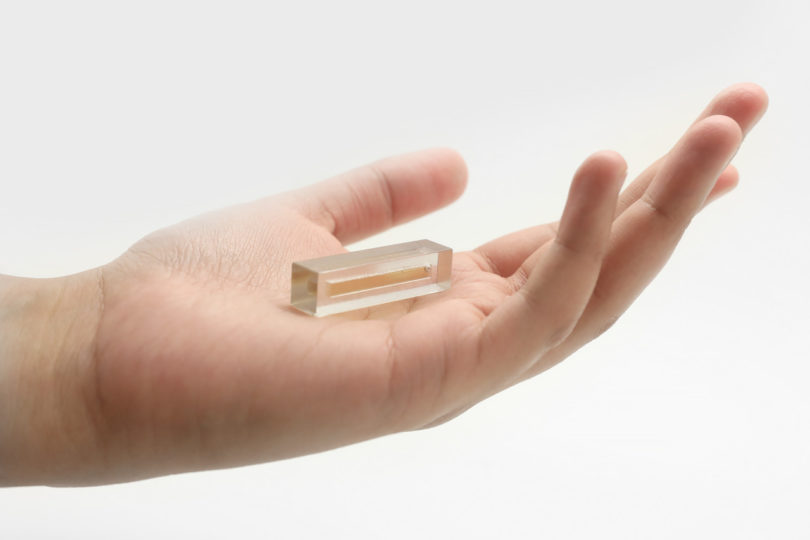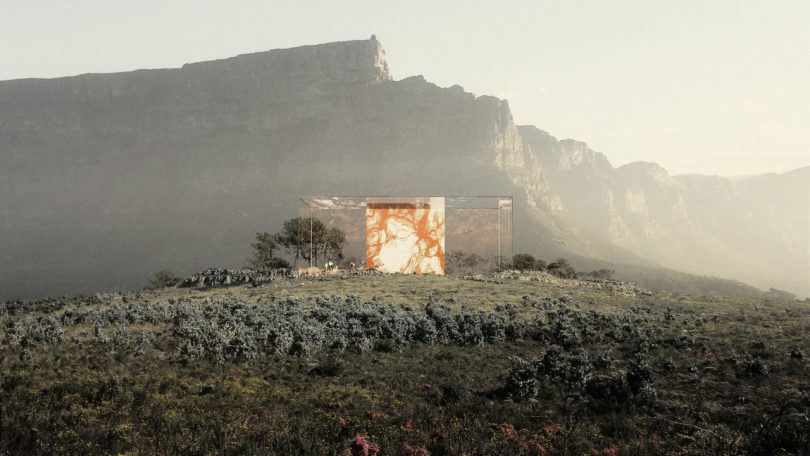The Mediated Matter Group’s installation Totems on display at the XXII Triennale di Milano prognosticates a future when designers will use laboratory synthesized melanin – the ‘universal pigment’ found in skin, fur, hair, and eyes – as an architectural resource to build glass windows that deepen or lighten in response to the sun like our own skin.
Designed for Broken Nature: Design Takes on Human Survival, Totem’s melanin-focused architectural application was initiated by Ravi Naidoo of Interactive Africa, but first proposed in 2018 by Neri Oxman and The Mediated Matter Group at Design Indaba in Cape Town. Oxman and her MIT team have developed numerous “living materials”, bio-inspired designs responsive to their environment, including melanin-impregnated material activated into varying colors with exposure to UV radiation (sunlight).

Liquid melanin is incorporated into channels within clear 3D printed pieces. A range of colors can be showcased in geometries ranging from simple to highly complex. Credit: Neri Oxman and The Mediated Matter Group.
The synthesized pigment merges digital fabrication and design computation with chemistry, resulting in a ‘chemical Totem’ – thus the name of the project – a reaction initiated by tyrosinase, a mushroom-derived enzyme that leads to color formations that change and deepen as the sun reaches its zenith.

Melanins are a group of pigments ranging in color from yellows to browns. The term ‘melanin’ often refers to eumelanin, a particular type that is brown-black in color. However, other types, such as pheomelanin (yellow-red in color), also exist. This ‘library’ represents the diversity of melanin, and includes constituent components of the reaction as well as melanin containing natural materials, such as feathers and cuttlefish ink. Credit: Neri Oxman and The Mediated Matter Group.

Melanin can also be incorporated into product scale structures such as the 12cm diameter sphere shown here. Its internal geometry and material distribution are computationally grown, 3D printed through high-resolution multi-material 3D printing and augmented with melanin drawn from different sources—from cuttlefish ink to mushrooms to bird feathers. Credit: Neri Oxman and The Mediated Matter Group.
The melanin-impregnated material is now proposed as an architectural element: melanin-infused glass. Designed to contain multiple types of melanin sourced from a variety of samples, including human hair, cuttlefish ink, mushrooms, bird feathers, and other sources, the bio-inspired material is currently represented in a small series of spherical objects featuring a single or multiple connected channel filled with liquid melanin, each showcasing a wide range of colors with their own unique light absorption properties. The hope is in time, liquid melanin would be incorporated into larger sheets of glass and used as transparent architectural surfaces as responsive and adaptive to the elements as our own skin.

A first of its kind biologically augmented facade, the structure is designed to protect endangered species on site and to celebrate the diversity of life on our planet. Created by Neri Oxman and members of The Mediated Matter Group for Design Indaba. Credits: Render by Eric de Broche des Combes, Luxigon. Courtesy of Neri Oxman and The Mediated Matter Group.
from WordPress https://connorrenwickblog.wordpress.com/2019/05/02/melanin-infused-glass-darkens-in-sunlight-like-pigment-in-our-skin/



No comments:
Post a Comment